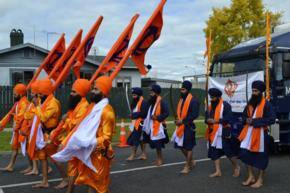Nanaksar Gurdwara Celebrates Vaisakhi with Nagar Kirtan

In Auckland, Thousands of Sikhs from different parts of New Zealand congregated at Nanaksar Gurdwara Manurewa to celebrate Vaisakhi – the birth of Khalsa - with Nagar Kirtan on Sunday, 26th April 2015.
The parade now in its 10th year, celebrates the religious festival of Vaisakhi, which marks the baptism of Sikhs by the 10th Guru, Guru Gobind Singh ji in 1699.
The programme started with Bhog of Sri Akhand Path (non-stop reading of the Holy Book) at 8.30 am followed by sewa of Sri Nishan Sahib. The Nagar Kirtan started at 11.30 am from Gurdwara Nanaksar with nearly 3000 people who walked behind a decorated truck that was carrying Guru Granth Sahib ji, through the streets of Manurewa. The procession was led by the “Panj Pyare” – the 5 beloved ones and went through Great South Road, Browns Road, Maich Road, Corin Avenue and came back to the Gurdwara at 1.30 pm. This was followed by religious singing (Kirtan) by Ragi’s and children.
Occasions like these give opportunities for parents to role model the religious practices and beliefs to their children and younger generation. Experiencing the spiritual environment helps the youth to understand their religion better who in turn become confident in their religion. This was exhibited by members of the Spoken Words Youth Group as well as several younger sewadars (volunteers).
The Nagar Kirtan had congregation members dressed in their traditional outfits with volunteers distributing fruits, juice and water to congregation members as well as by-standers promoting the value of “vandd ke chaknaa” – sharing with others. Gatka groups comprising of young and old, displayed Sikh Martial art skills.
In Sikhism, Vaisakhi is one of the most significant holidays in their calendar.
In the Punjab region of India, Vaisakhi is also the ancient harvest festival that marks the beginning of a new year. It falls in the middle of the month of April because this marks the harvest time of the winter crops.
In Auckland, Thousands of Sikhs from different parts of New Zealand congregated at Nanaksar Gurdwara Manurewa to celebrate Vaisakhi – the birth of Khalsa - with Nagar Kirtan on Sunday, 26th April 2015.
The parade now in its 10th year, celebrates the religious festival of Vaisakhi, which marks the...
In Auckland, Thousands of Sikhs from different parts of New Zealand congregated at Nanaksar Gurdwara Manurewa to celebrate Vaisakhi – the birth of Khalsa - with Nagar Kirtan on Sunday, 26th April 2015.
The parade now in its 10th year, celebrates the religious festival of Vaisakhi, which marks the baptism of Sikhs by the 10th Guru, Guru Gobind Singh ji in 1699.
The programme started with Bhog of Sri Akhand Path (non-stop reading of the Holy Book) at 8.30 am followed by sewa of Sri Nishan Sahib. The Nagar Kirtan started at 11.30 am from Gurdwara Nanaksar with nearly 3000 people who walked behind a decorated truck that was carrying Guru Granth Sahib ji, through the streets of Manurewa. The procession was led by the “Panj Pyare” – the 5 beloved ones and went through Great South Road, Browns Road, Maich Road, Corin Avenue and came back to the Gurdwara at 1.30 pm. This was followed by religious singing (Kirtan) by Ragi’s and children.
Occasions like these give opportunities for parents to role model the religious practices and beliefs to their children and younger generation. Experiencing the spiritual environment helps the youth to understand their religion better who in turn become confident in their religion. This was exhibited by members of the Spoken Words Youth Group as well as several younger sewadars (volunteers).
The Nagar Kirtan had congregation members dressed in their traditional outfits with volunteers distributing fruits, juice and water to congregation members as well as by-standers promoting the value of “vandd ke chaknaa” – sharing with others. Gatka groups comprising of young and old, displayed Sikh Martial art skills.
In Sikhism, Vaisakhi is one of the most significant holidays in their calendar.
In the Punjab region of India, Vaisakhi is also the ancient harvest festival that marks the beginning of a new year. It falls in the middle of the month of April because this marks the harvest time of the winter crops.









Leave a Comment